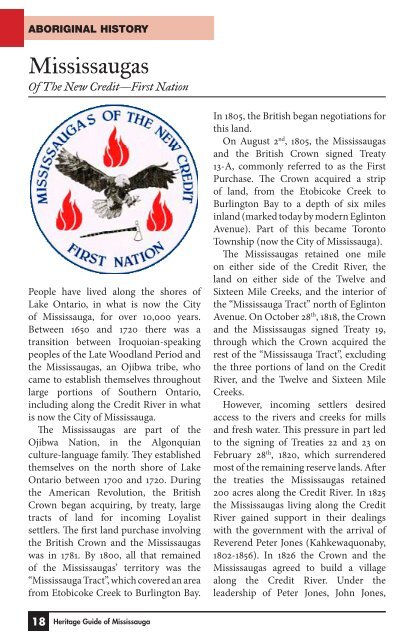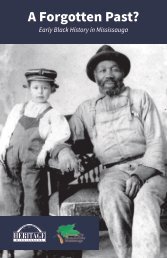Heritage Mississauga Heritage Guide
Create successful ePaper yourself
Turn your PDF publications into a flip-book with our unique Google optimized e-Paper software.
Aboriginal history<br />
<strong>Mississauga</strong>s<br />
Of The New Credit—First Nation<br />
People have lived along the shores of<br />
Lake Ontario, in what is now the City<br />
of <strong>Mississauga</strong>, for over 10,000 years.<br />
Between 1650 and 1720 there was a<br />
transition between Iroquoian-speaking<br />
peoples of the Late Woodland Period and<br />
the <strong>Mississauga</strong>s, an Ojibwa tribe, who<br />
came to establish themselves throughout<br />
large portions of Southern Ontario,<br />
including along the Credit River in what<br />
is now the City of <strong>Mississauga</strong>.<br />
The <strong>Mississauga</strong>s are part of the<br />
Ojibwa Nation, in the Algonquian<br />
culture-language family. They established<br />
themselves on the north shore of Lake<br />
Ontario between 1700 and 1720. During<br />
the American Revolution, the British<br />
Crown began acquiring, by treaty, large<br />
tracts of land for incoming Loyalist<br />
settlers. The first land purchase involving<br />
the British Crown and the <strong>Mississauga</strong>s<br />
was in 1781. By 1800, all that remained<br />
of the <strong>Mississauga</strong>s’ territory was the<br />
“<strong>Mississauga</strong> Tract”, which covered an area<br />
from Etobicoke Creek to Burlington Bay.<br />
In 1805, the British began negotiations for<br />
this land.<br />
On August 2 nd , 1805, the <strong>Mississauga</strong>s<br />
and the British Crown signed Treaty<br />
13-A, commonly referred to as the First<br />
Purchase. The Crown acquired a strip<br />
of land, from the Etobicoke Creek to<br />
Burlington Bay to a depth of six miles<br />
inland (marked today by modern Eglinton<br />
Avenue). Part of this became Toronto<br />
Township (now the City of <strong>Mississauga</strong>).<br />
The <strong>Mississauga</strong>s retained one mile<br />
on either side of the Credit River, the<br />
land on either side of the Twelve and<br />
Sixteen Mile Creeks, and the interior of<br />
the “<strong>Mississauga</strong> Tract” north of Eglinton<br />
Avenue. On October 28 th , 1818, the Crown<br />
and the <strong>Mississauga</strong>s signed Treaty 19,<br />
through which the Crown acquired the<br />
rest of the “<strong>Mississauga</strong> Tract”, excluding<br />
the three portions of land on the Credit<br />
River, and the Twelve and Sixteen Mile<br />
Creeks.<br />
However, incoming settlers desired<br />
access to the rivers and creeks for mills<br />
and fresh water. This pressure in part led<br />
to the signing of Treaties 22 and 23 on<br />
February 28 th , 1820, which surrendered<br />
most of the remaining reserve lands. After<br />
the treaties the <strong>Mississauga</strong>s retained<br />
200 acres along the Credit River. In 1825<br />
the <strong>Mississauga</strong>s living along the Credit<br />
River gained support in their dealings<br />
with the government with the arrival of<br />
Reverend Peter Jones (Kahkewaquonaby,<br />
1802-1856). In 1826 the Crown and the<br />
<strong>Mississauga</strong>s agreed to build a village<br />
along the Credit River. Under the<br />
leadership of Peter Jones, John Jones,<br />
18 <strong>Heritage</strong> <strong>Guide</strong> of <strong>Mississauga</strong>









